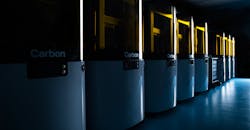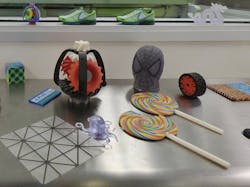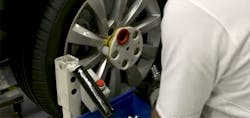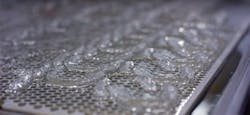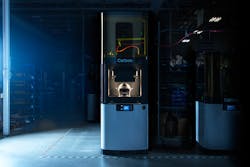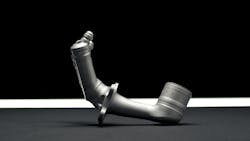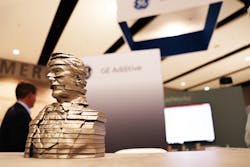State of 3D Printing 2019: All Grown Up & Ready to Work
Since I started covering the 3D printing industry in 2015, even the most eccentric new developments commanded my full attention. OK, especially the eccentric ones. Battle armor for a cat? Definitely writing about that. Oh, cosmonauts bioprinted a mouse's thyroid, you say? Hold all my calls. And don't even get me started on Siemens' 3D-printing robot spiders.
In the past, I didn’t particularly care if it advanced beyond novelty uses and sensational-but-impractical advances. It was a young technology, a toddler compared to manufacturing's mature, reliable workhorses: milling, casting, injecting molding. And kids will be kids, right?
Full of wonder and mystery, it represented pure potential. Sometimes it was used to make pancakes that looked like astronauts; later, parts for the International Space Station.
"If you can dream it, you can make it." That's how we've been trained to think about the future of 3D printing. At some point these emerging technologies, they have to grow up. They have to, you know, emerge. And after seeing maybe one too many adorable uses, (although still really love the Parisian style homes for hermit crabs), yeah, it's time for 3D printing to live up to its true capabilities.
It's time to shout: Move out of the lab, 3D printing. Find a real job. Change the dang world, why doncha'?
When exactly would this thirtysomething grow up?
For the past six months I've been immersed in answering that question, asking those closest to the technology when that might be. Because this is a story about a technology known for speeding things up, I'll bypass the unknown and first tell you it's this year. (It was in the headline after all.) Full maturity, fully emerged and for the right applications, wholly indispensable. That's the state of the 3D printing in 2019.
Permanent Fixture on the Factory Floor
Visit a 3D print lab, or a booth at a trades show, and you'll see a lot of 3D-printed superheroes and wacky brightly colored creatures. The idea is to show off a machine's knack for nailing details and material and garner passerby's attention. A "look-what-I-can-do" sort of thing. At some point, children, and anthropomorphized technology, must move out of the basement and get a real job. And the factory has proved to be additive manufacturing’s best setting, specifically for making tools, fixtures and jigs.
Not sexy, but it's a living.
"We started seeing the possibilities and what the advantages would be in the late '80s," explains Chuck Hull, one of the Fathers of 3D Printing, referring to how manufacturers could use 3D printing on the production floor.
He invented stereolithography (SLA) in the early 1980s after his boss told him not to spend company time on the hypothetical process of building a part layer by layer (by curing a special resin with light attached to an X-Y plotter).
Hull didn’t spend much time thinking about possibilities back then. He just wanted to cut down on the six-week wait time for designers from drawing a part to having a prototype in hand. By the end of the decade, the company he co-founded, and of which he is currently CTO, 3D Systems, was making investment casting patterns for foundries.
"We could make these patterns at least in enough volume for foundries to do short run production," Hull recalls. He says it was mainly for fixtures and tooling and went into factories.
Thirty years later, this appears to be the most approachable application, as every manufacturer understands the need for the right tooling, jigs and fixtures. And the ROI is nearly as easy to comprehend.
With the Ultimaker 2+ and Ultimaker 3 3D printers, which use fused filament fabrication (FFF), Volkswagen estimated it saved $377,000 by printing fixtures and tools at its Portugal plant in 2017.
"It used to be if they wanted one of these parts, it would cost $200 to get the part, and it would take a couple of weeks," says John Kawola, Ultimaker's North American president. "Now they can print it in a couple hours and cost $20."
Kawola calls the move going from "the carpet to the concrete."
Jabil, which has 42 million square feet of manufacturing space across 120 sites, relies heavily on the additive process to speed up its workholding innovation. It also has an impressive innovation lab in San Jose, Calif., replete with all those aforementioned colorful prints, along with actual manufacturing tools such as for sneaker insoles.
"I can’t think of an application where we don't use 3D printing," says John Dulchinos, Jabil's VP of Digital Manufacturing. "All of our factories have some 3D printing capability in them for fixtures, jigs and tooling."
At its Auburn Hills plant in Michigan, Jabil says it has saved 35% on tooling costs and 80% on delivery time by 3D printing tools and fixtures.
The speed to solve problems on the plant floor invariably leads to higher efficiency, too.
One notable example Dulchinos cites is regarding workholding that testers would place a certain electronic medical device in. Kaizen practices identified a quality issue where the tester's finger could cover a circuit and short it out.
"That day the engineer downloaded it into CAD, put in the ribs, and by the end of the day, we had an updated fixture in place that solved that problem," Dulchinos says.
Honeywell Federal Manufacturing & Technologies perhaps has the most obscene savings. As of FY 2018, they have printed more than 60,000 tooling fixtures for product testing and calculated $125 million in cost avoidance. Its customer is the Department of Energy’s Kansas City National Security Campus, which makes non-nuclear components for national defense systems.
"Jigs and fixtures are low-hanging fruit," says David McMindes, Honeywell FM&T CTO. "It's a very nice market for making a lot of small high precision pieces. [We] don't make thousand anything—in hundreds or less— so additive fits here."
Cranking Up the Volume
If maturity means just getting and being good at a job, I personally would have been very mature at 16…and I most certainly was not. It's not enough for 3D printing, which, again, has the limitless potential to make anything out of any material, to settle as an assistant for older manufacturing techniques like machining.
Moving up and accruing more responsibility takes time, trust and experience.
That's exactly what has happened as HP, Carbon, EOS and Desktop Metal have set out to disrupt the economic expectations of large-scale additive applications. Desktop, which claims with its Production System to have the fastest metal printer in the world (up to 12,0000 cm³/hr) recently received $160 million (led by Koch Industries) to reach $483 million total in venture capital. The build size is also huge: 750 x 330 x 250 mm. It's expected out this year and by the crowds huddled around it at IMTS 2018, the industry can't wait.
"All of these things have moved the bar in terms of what the breakeven point is between 3D printing and traditional manufacturing," Dulchinos says. "Now we have applications in the tens of thousands and in some cases hundreds of thousands."
While countless companies are pushing towards high volume, the progenitor of it all, 3D Systems, has spurred the highest volume application with its SLA process. They created an automated solution for Align Technologies, makers of Invisalign clear aligners, to produce more than 350,000 unique (several for each patient) aligners— per day! The 3D printing process is used to create a mold for each thermoform aligner.
"The scale is the biggest volume application 3D printing has been involved in," Dulchinos notes. "It's very impressive."
Align surely agree, as its customer base has expanded 600% in less than a decade, and they expect to grow in China by up to 20% a year.
"They figured out there is a phenomenal need: no one likes braces and wire," explains 3D Systems CEO Vyomesh Joshi, an excitable figure who I chatted with at IMTS. While Hull is down-to-earth, even casual, about his creation, Joshi, who once ran HP's entire 2D printing business, is exploding with palpable energy, charged by what's building in the industry.
But it would be folly to confuse Joshi's unbridled excitement with typical emerging tech hype. He is amped up over some fairly boring, but incredibly vital, reasons. He speaks of improving quality and reliability, and most of all workflows for each specific application.
The actual manufacturing of the aligners, at such a high volume and amount of customization, could obviously fall apart faster than a hockey player's teeth without the right workflow. Incorrectly matching patients to of aligners would be reason enough for many not to smile. But the workflow starts in the orthodontist's chair, and how they train these dentists to use the 3D scanners.
"You have to get the fundamentals right," Joshi says. "And figure out how you very predictably manage that in a high productivity environment."
He says 2019 will be about manufacturers finding the right workflows.
"You have the platforms now," he says. "Materials innovation, training and awareness are going to be the facing item."
Getting a Doctorate
Going into the medical profession is a sure sign of "making it." They have the most rigid standards and only the most mature would ever want to deal with: FDA oversight, threats of malpractice, and constantly helping people even if they don’t like them. No thanks.
But this is where additive will perhaps excel the most in the long term. It's made itself known in the public eye, with amazing stories such as Hailey's Dawson's, a girl who, while wearing 3D-printed hand prosthesis, threw out the first pitch at every Major League ballpark, including a World Series game.
I'm all for bottling up feelings, but this kid's story always makes me want to ugly cry. Her struggle wasn't life-threatening, but the awareness she catalyzed will help generations of kids who couldn’t afford traditional prosthetics lead more active lives.
And helping people seems a much more practical use of 3D printing than hermit crab mansions. Medical manufacturers are taking notice.
Ten percent of medical devices will be 3d printed, Joshi estimates.
"We’ve reached critical mass," he says. "I think you're going to find a lot more Aligns in the next ten years. Align has a $23 billion market cap."
It's driven by the need for customization, as everyone's body is somewhat different.
"Nobody would make aligners without the 3D printing process," Dulchinos says. "Once 3D printing has proven itself, an industry almost 100% switches over to 3D printing in a very short amount time."
The hearing aid industry has seen a nearly 100% transformation to 3D printing.
And it won’t be long before actual organs are 3D printed on a regular basis, from lungs to kidneys. Try that on a CNC machine.
Hull, as a good father is wont to do, refuses to let 3D printing get a big head even in this amazing advanced use case
"I'm also familiar with how much work it is to go from this concept to making them happen," Hull says. "So there's lots of research, lots of effort to be done still before a lot of these miraculous things happen."
Owning (Virtual) Real Estate
3D printing miracles don’t happen overnight. That much is true, but they can happen in two.
When a critical part on aircraft in Europe went down, Fast Radius, a company at the forefront of additive on-demand services, came to the rescue.
"Normally this part took 48 days to fabricate," Fast Radius CEO Lou Rassey says. "We made it and delivered it in 48 hours. "
Fast Radius formed just off the UPS airstrip in Louisville in 2015. Sample parts and prototypes would roll off the production line and almost directly onto an airplane for delivery. The recent opening of its Chicago facility last August signals its intention to disrupt the supply chain even more.
Using HP's Multi Jet Fusion printer and Carbon's M1, both top-tier in speed and quality, the parts created can meet manufacturing's need and Fast Radius' cloud-based solution has become a virtual warehouse for industrial manufacturers seeking leaner operations.
"The rule of thumb is that the cost of storing a part is 25% of its cost.," Rassey says. "Think of product companies that need to store parts for a decade or more. The cost of storage far exceeds cost of making part."
Rassey says once industrial equipment manufacturer has 3,000 parts in its database for spare tractor parts.
"They can make one of these and not need to make 20," Rassey says. "It's exactly what they need when it's needed."
Fast Radius has built an operating system to ensure every piece of the PLC pie is accounted for virtually, including the design, build instructions, support, material formulation, materials, monitoring, environment, post-processing, metrology and quality control.
This will ensure "the part we made today is same five years ten years from now," Rassey explains.
Taking over real estate, even if it's virtual. That's adulting of the highest order.
But still, the reason machining and injection molding have never sweated additive manufacturing before is because of how difficult it is to print any part, not just a liver or spleen.
"There is a misperception in the industry that I can buy a 3D printing machine, plug it into the wall and get a good part out just like I could with a 2D paper printer," Rassey says. "For the industrial parts we're talking about, they're much more sophisticated. There is a workflow before the machine and after the machine with hundreds of variables that need to be dialed in and controlled to make sure you're getting an industrial-grade part reliably and repeatably."
Fast Radius has built an operating system to ensure every piece of the PLC pie is accounted for virtually, including the design, build instructions, support, material formulation, materials, monitoring, environment, post-processing, metrology and quality control.
This will ensure "the part we made today is same five years ten years from now," Rassey explains.
Industry-Wide Adoption
For the applications previously mentioned, additive manufacturing is really a no-brainer. For it to truly be considered the driver of the digital transformation, (a tall task for a thirtysomething), the technology must move beyond niche use cases and huge companies.
To do that, it need an experienced mentor, a wealthy patron if you will. It has that in General Electric, and its three-year-old business, GE Additive, which offers machines that harness electron beam melting and laser additive technology.
GE famously began mass printing the metal fuel nozzle for GE Aviation's LEAP engine in 2015. It really put metal 3D printing on the map, allowing what was 20 parts to become one, removing unnecessary tooling for those parts and eliminating the welding and brazing process.
Aviation is as stringent, maybe more than medical, and GE has mastered how and where to use additive. Now it wants to give moms and pops, or small and medium enterprises, the same chance to innovate metal printing in their respective fields.
"I think many customers still view this as a research tool, or as a tool for R&D and universities—it's not," says Christine Furstoss, CTO of GE Additive.
Still, it has taken a high degree of skill and manufacturing prowess to get consistent, reliable parts, non-negotiable aspects of manufacturing.
"We're working with electron beams and lasers, these are high heat sources," explains Furstoss, a metallurgist by trade. "Things sometimes distort, they change, they move. Fine tuning that has become a very iterative process."
In May, the company is rolling out the preparation workflow suite to make these metal 3D printing less esoteric and more approachable, and thus adoptable.
"Large understand how to slice up design [to get it ready to print]," Furstoss explains. "Small and medium, might run with a staff of ten engineers and we want to make it easier for them."
Not knowing the ins and outs of metal has made it so the average development time is six months, taking dozens of iterations, Furstoss says. This can all be done digitally now, with GeonX Virfac 3D printing simulation software, which will predict defects, distortion and stresses.
Using this tool, Furstoss believes that can be brought "down to single digits of trials and down to a month to two weeks—a factor of three to four reduction."
Furstoss distills it even further.
"It's all about productivity," she says. "The whole industry evolved. Additive has not traditionally been a fast process, but now with these new advances, productivity increases are one and half to two times what they were before."
And in the end, this isn’t about one technology maturing and growing up. It's just another example of continuous improvement methods that some companies have recognized to reap great success and higher productivity. It's not the only answer, but it's time to have adult conversations about it, and not get wrapped in the silly novelties and one-offs.
"You've got to think about the sweet spot of the technology," Joshi concludes. "Molding is ideal if you want to do 100 million parts and it’s a known process. If it's a complex part, where yields low, and has thin walls, then you think about additive manufacturing."
About the Author
John Hitch
Senior Editor
John Hitch writes about the latest manufacturing trends and emerging technologies, including but not limited to: Robotics, the Industrial Internet of Things, 3D Printing, and Artificial Intelligence. He is a veteran of the United States Navy and former magazine freelancer based in Cleveland, Ohio.
Questions or comments may be directed to: [email protected]
